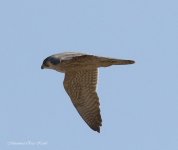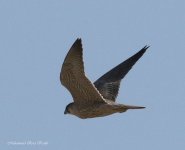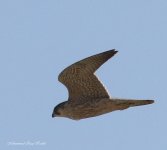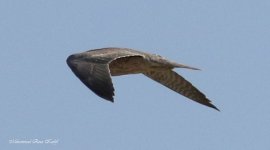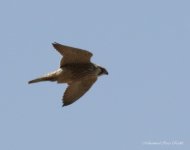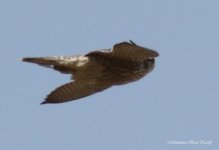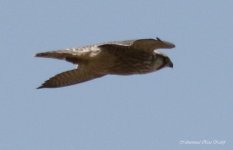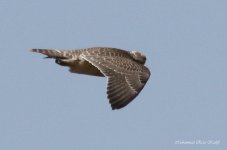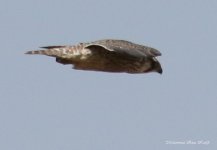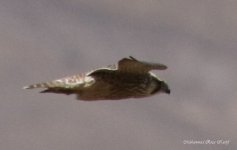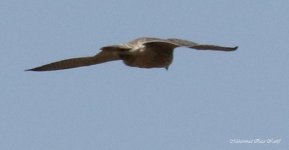-
Welcome to BirdForum, the internet's largest birding community with thousands of members from all over the world. The forums are dedicated to wild birds, birding, binoculars and equipment and all that goes with it.
Please register for an account to take part in the discussions in the forum, post your pictures in the gallery and more.
You are using an out of date browser. It may not display this or other websites correctly.
You should upgrade or use an alternative browser.
You should upgrade or use an alternative browser.
Falcon? (1 Viewer)
- Thread starter smr.kashfi
- Start date
More options
Who Replied?smr.kashfi
Member
smr.kashfi
Member
smr.kashfi
Member
Looks massive, Barbary jvenile probably female
Is there any chance for pregrine?

Is there any chance for pregrine?
Juvenile calldus can look like the second bird, but I doubt they would ever be that far souh in August
Juvenile calldus can look like the second bird, but I doubt they would ever be that far souh in August
Agree, and besides its a tough lived myth that you're able to tell calidus (in ether juvenile or adult plumage) from peregrinus.
The considerable variation of peregrinus with its clinal tendency to larger and paler individuals towards the northeast in its distribution renders any attempt to stick the calidus label to ANY* Peregrine quite futile.
Just my penny, but Dick Forsman shares my view and doesn't quote the flights of fancy some birders have indulged in when they have claimed that juvenile calidus have an - in the field noticeable longer tail - than that of the nominateo
*The only difference between my view and Dick's is that he strangely enough seems to hold this view: "Of these two subspecies only the most typical individuals should be identified...." whereafter he continues by eracidating his own conclusion (that some individuals may be separated in the field) by telling us why my view (that even the most "typical" calidus could easily belong to ssp peregrinus) is a proven fact.
Maybe he's aware of the die-hard myth among many birders (that the two subspecies can be told apart in the field) and feels that this misperception is in a sense too holy to simply liquidate, so he waters down his own conclusions with a soft spoken generality?
A subject for a conversation the next time I meet him?
I quote from his new book:
"Nominate peregrinus breeds over most of Europe and the temperate zone of Asia, with northern populations being migratory, wintering as far south as the Mediterranean basin and Africa. The long-winged arctic ssp. calidus from the Russian tundra east of the White Sea is a long-distance migrant to temperate and tropical parts of Asia and Africa, even reaching S.Africa, passing through Europe on migration. Of these two subspecies only the most typical individuals should be identified, as peregrinus and calidus seem to integrate over a wide area. For instance, some birds from Taimur, which should be calidus on breeding range, may look like peregrinus, while many Finnish breeding birds (ssp. peregrinus by definition) approach the phenotype of calidus. Ssp. calidus may in fact represent the extreme in a cline, in which Peregrines gradually get paler and less heavily marked from C Europe towards the north-east."
No offense to you Tom, but I've just heard the cliche "a typical calidus" too often to allow myself to surrender to this....let's just call it......mythB
Peter
Last edited:

Agree, and besides its a tough lived myth that you're able to tell calidus (in ether juvenile or adult plumage) from peregrinus.
The considerable variation of peregrinus with its clinal tendency to larger and paler individuals towards the northeast in its distribution renders any attempt to stick the calidus label to ANY* Peregrine quite futile.
Just my penny, but Dick Forsman shares my view and doesn't quote the flights of fancy some birders have indulged in when they have claimed that juvenile calidus have an - in the field noticeable longer tail - than that of the nominateo
*The only difference between my view and Dick's is that he strangely enough seems to hold this view: "Of these two subspecies only the most typical individuals should be identified...." whereafter he continues by eracidating his own conclusion (that some individuals may be separated in the field) by telling us why my view (that even the most "typical" calidus could easily belong to ssp peregrinus) is a proven fact.
Maybe he's aware of the die-hard myth among many birders (that the two subspecies can be told apart in the field) and feels that this misperception is in a sense too holy to simply liquidate, so he waters down his own conclusions with a soft spoken generality?
A subject for a conversation the next time I meet him?
I quote from his new book:
"Nominate peregrinus breeds over most of Europe and the temperate zone of Asia, with northern populations being migratory, wintering as far south as the Mediterranean basin and Africa. The long-winged arctic ssp. calidus from the Russian tundra east of the White Sea is a long-distance migrant to temperate and tropical parts of Asia and Africa, even reaching S.Africa, passing through Europe on migration. Of these two subspecies only the most typical individuals should be identified, as peregrinus and calidus seem to integrate over a wide area. For instance, some birds from Taimur, which should be calidus on breeding range, may look like peregrinus, while many Finnish breeding birds (ssp. peregrinus by definition) approach the phenotype of calidus. Ssp. calidus may in fact represent the extreme in a cline, in which Peregrines gradually get paler and less heavily marked from C Europe towards the north-east."
No offense to you Tom, but I've just heard the cliche "a typical calidus" too often to allow myself to surrender to this....let's call it......mythB
Peter
:t:

Can these two migratory northern subspecies of peregrine be seperable from local pelegrinoides in juvenile plumage by these kind of pics?
Maybe the shorter wing and tail of pelegrinoides?
Imho the sandy dark markings of the first bird would be unusual in Peregrine both peregrinus, callidus and even in the most light juvenile brookei
(as always other opinions most welcome)
Dick F has told me that I have indulged in such flights of fancy in my writings about tundrius and calidus as identifiable vagrants to Britain. In my defence, I have tried to limit my guesses to extreme-looking juveniles only - wouldn't dare play with adults. There's a potential candidate calidus type here at the moment (see http://www.cleybirds.com/ )
Dick F has told me that I have indulged in such flights of fancy in my writings about tundrius and calidus as identifiable vagrants to Britain. In my defence, I have tried to limit my guesses to extreme-looking juveniles only - wouldn't dare play with adults. There's a potential candidate calidus type here at the moment (see http://www.cleybirds.com/ )
To me the fresh juvenile female linked to can just as well be a finely marked nominate since the all its features can be seen on even Danish juveniles (yes, also the pale crown.)
How on earth are juveniles from the northern subspecies then distinguishable from each other when nobody knows where they come from?
Could be Finland, Sweden, Norway....and Siberia (where ringing is supposedly almost non-existent.)
This myth is really nothing more than just that unless/until collected or measured/photographed juveniles locally bred in Siberia are proved to differ from locally bred Scandinavian - and even Scottish - birds.
And until these (possible) but hitherto unknown differences may prove at all relevant for use in the field.
One of the most prominent advocates for this myth is not mentioned in Dick Forsman's acknowledgements in the foreword to his latest book.
I truly hope this has something to do with the "looong-tailed" juveniles repeatedly identified as calidus from this particular birder. Something I have never seen the slightest evidence for.
I guess this misperception is something I have to live and die with:-C
Peter
Last edited:
ehsan
Ehsan Talebi

Many thanks TomImho the sandy dark markings of the first bird would be unusual in Peregrine both peregrinus, callidus and even in the most light juvenile brookei
(as always other opinions most welcome)
Tib78
Well-known member
Maybe the shorter wing and tail of pelegrinoides?
Yes, this is especialy obvious on the first bird thats clearly has a very compact shape, typical of Southern birds.
I'll try to look for pictures, but Finnish juveniles could be interesting too. They are certainly peregrinus though the adults (according to Dick Forsman) at times look more like calidus than do some dead-sure adult calidus from Taimur........
Confused?
Then just refrain from naming any calidus, but birds ringed as nestlings within the acknowledged distribution of calidus (and of course adults collected in the breeding season with similar provenance)
This myth will thereafter bury itself deep in the permafrost of the Siberian tundra.
Good riddance:t::t::t:
PS Richard, here links to two discussions on a former Danish forum. I share your fascination of embracing the task to safely identify the calidus Peregrines migrating through Europe, and hope that a Google translate might help to expose how little definite knowledge we currently have on the subject.
http://www.netfugl.dk/pictures.php?id=showpicture&picture_id=16591
http://www.netfugl.dk/pictures.php?id=showpicture&picture_id=16663
Peter
Confused?
Then just refrain from naming any calidus, but birds ringed as nestlings within the acknowledged distribution of calidus (and of course adults collected in the breeding season with similar provenance)
This myth will thereafter bury itself deep in the permafrost of the Siberian tundra.
Good riddance:t::t::t:
PS Richard, here links to two discussions on a former Danish forum. I share your fascination of embracing the task to safely identify the calidus Peregrines migrating through Europe, and hope that a Google translate might help to expose how little definite knowledge we currently have on the subject.
http://www.netfugl.dk/pictures.php?id=showpicture&picture_id=16591
http://www.netfugl.dk/pictures.php?id=showpicture&picture_id=16663
Peter
Last edited:
Thanks for the links.
I wouldn't support either as being calidus (well, the adult I'd pass on anyway...). The juv looks pretty uninspiring to my eyes (though pics not the best...)
Interestingly, the current Norfolk bird hunts Gyr-style (low sweeps of beaches, chasing big gulls etc), with no attempt at gaining any height. ie Tundra-style?
I wouldn't support either as being calidus (well, the adult I'd pass on anyway...). The juv looks pretty uninspiring to my eyes (though pics not the best...)
Interestingly, the current Norfolk bird hunts Gyr-style (low sweeps of beaches, chasing big gulls etc), with no attempt at gaining any height. ie Tundra-style?
Users who are viewing this thread
Total: 2 (members: 0, guests: 2)




